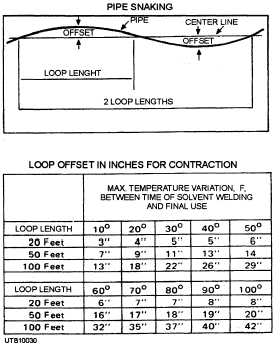
Figure 3-30. - Threading plastic pipe.
dries during the cool of the night, the thermal contraction of the pipe could stress the joint and pull the pipe apart due to the inadequate time to allow for the cement to cure. See table 3-1 for a general guideline on "loop" dimensions for various lengths of line and temperature ranges.
TESTING. - Testing should be done in two intervals:
1. The initial test should be a low-pressure hydrostatic test. (Air or gas is NOT recommended.) This test should never exceed 50 pounds per square inch gauge (psig). When testing with a gauge, allow the pipe to remain under pressure for a few hours; then check to see if there is a pressure drop. When the pressure drops, there is a leak. The pipeline should then be walked and closely inspected, checking each joint closely. After
Table 3-1. - Pipe Snaking Loop Offset

locating the leak, repair it, and pressurize it again using LOW pressure.
2. After completion of the low-pressure test, place the pipeline in the trench (if not tested in the ditch) and backfill, leaving the joints exposed. The pipe should be uniformly and constantly supported its entire length. DO NOT SUPPORT WITH BLOCKS. The high- pressure test should be conducted at 1 1/2 times the working pressure and be held for at least 12 hours. Leaks found on the pipe itself should be cut out completely and replaced by using fittings (couplings). Backfill in the early morning during hot weather. The pipe should be covered 6 to 8 inches with backfill that is free of rocks and debris. It is advisable to maintain a pressure of 15 to 20 psig on the pipeline while backfilling to keep from damaging it. Anchors, valves, boxes, and so forth, should be supported separately to prevent additional stress or bending from the pipe. Piping, under roadways or railroads, should be done with sleeving (metal or concrete). The pipe should be isolated from direct contact with the concrete. When concrete anchors are being poured, wrap the pipe with rubber or other protective material. If the anchor is for axial movement, use the solvent welding process to weld a split collar to the pipe to provide the needed protection. When solvent welding collars on the pipe, allow 48 hours for drying time before pouring concrete.
Q3. What is the main purpose of a sanitary sewage collection system?
Continue Reading